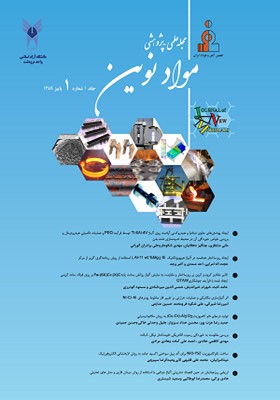بررسی رفتار کششی غیرمتعارف فولاد کم آلیاژ کم کربن DIN 16MnCr5 در حالت دو فازی فریتی-مارتنزیتی در مقایسه با شرایط تمام مارتنزیتی
محورهای موضوعی : فصلنامه علمی - پژوهشی مواد نوینحمید رضا پاکزمان 1 , سید صادق قاسمی بنادکوکی 2 *
1 - دانشکده مهندسی معدن و متالورژی، بخش مهندسی مواد، دانشگاه یزد، یزد، ایران
2 - دانشکده مهندسی معدن و متالورژی، بخش مهندسی مواد، دانشگاه یزد، یزد، ایران
کلید واژه:
چکیده مقاله :
در این پژوهش، ریزساختارها و خواص مکانیکی فولاد کم آلیاژ 16MnCr5 DIN در حالت دوفازی فریتی-مارتنزیتی (با کسر حجمی مختلف مارتنزیت) در مقایسه با شرایط تمام مارتنزیتی مورد بررسی قرار گرفت. برای ایجاد ریزساختارهای دوفازی، نمونههای فولادی در دماهای میانبحرانی مختلفی از 740 تا ˚C 840 به مدت 60 دقیقه حرارت داده شده و سپس در آب کوئنچ شدند. برای ایجاد ریزساختار تمام مارتنزیتی، نمونهها پس از آستنیته شدن در دمای ˚C 900 به مدت 60 دقیقه، بلافاصله در آب کوئنچ گردیدند. برای بررسی و مقایسه ریزساختار و خواص مکانیکی نمونهها از میکروسکوپ الکترونی روبشی مجهز به آنالیزگر EDS، پراش اشعه ایکس و آزمونهای کشش و میکروسختی سنجی استفاده شد. نتایج متالوگرافی نشان داد با افزایش دمای آنیل میانبحرانی از 740 به ˚C 840، کسر حجمی مارتنزیت (Vm) از 23 به 87% افزایش مییابد. مقایسه خواص مکانیکی نمونههای دوفازی نشان داد که با افزایش Vm از 23 تا 87%، رفتار کششی غیرمتعارفی در 73%= Vmایجاد شد به طوری که نمونههای دوفازی فریتی-مارتنزیتی در مقایسه با نمونههای تمام مارتنزیتی از قابلیت جذب انرژی (حاصلضرب استحکام کششی در ازدیاد طول یکنواخت) به مراتب بالاتری برخوردار میباشند. این اصلاح شگرف در خواص مکانیکی نمونههای دوفازی ناشی از اثرات سختگردانی متفاوت فازهای فریت و مارتنزیت در اثر برهمکنش بین آنها میباشد. با افزایش Vm از 23 تا 87%، میکروسختی مارتنزیت به طور پیوسته از 717 به HV10g 471 کاهش مییابد؛ در حالیکه میکروسختی فاز فریت در 73%= Vmبه پیک سختگردانی خود میرسد.
In this research, the microstructures and mechanical properties of DIN 16MnCr5 low alloy steel under ferrite-martensite dual-phase (with various martensite volume fraction) were compared to full martensitic condition. Dual-phase microstructures were developed by inter-critical annealing. For this purpose, the samples were heated at various inter-critical temperatures (from 740 to 840 °C) for 60 minutes and then water quenching to room temperature. Also, to develop full martensitic microstructure, steel samples were immediately quenched in water after austenitization at 900 ˚C for 60 minutes. The microstructure and mechanical properties of the specimens were analyzed by scanning electron microscope equipped with EDS analyzer, X-ray diffraction and tensile and microhardness tests, respectively. Metallographic observations showed that by increasing the inter-critical annealing temperature from 740 to 840 °C, the martensite volume fraction (Vm) increased from 23 to 87%. Comparison of mechanical properties of dual-phase samples showed that by increasing Vm from 23% to 87%, there was an abnormal tensile behavior at Vm=73%, so that the energy absorption capability (product of tensile strength and uniform elongation) for ferrite-martensite dual-phase samples is much higher than to full martensitic samples. This remarkable modification in the mechanical properties of the dual-phase samples is due to the different hardening responses of the ferrite and martensite microconstituents because of the interaction between them. By increasing the Vm from 23 to 87%, the martensite microhardness decreased continuously from 717 to 471 HV10g, while the ferrite microhardness showed a peak value at Vm=73%.

